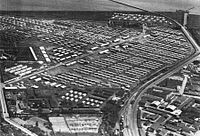Kløvermarken
Kløvermarken (the Clover Field) is a large green space in the Amager East district of Copenhagen, Denmark.
Originally a military area, it has later been home to both Copenhagen's first air field and a camp for German refugees after World War II.
[1] At that time the area reached all the way to the Øresund coast where the Stricker Battery had been constructed in 1801 as the most southernly point on Copenhagen's fortifications.
In 1925, the civilian flights moved to the new Copenhagen Airport a little further down the coast, at Kastrup, and a couple of years later they were joined by the military activities.
In 2005, in response to Lord Mayor Ritt Bjerregaard's launching of an affordable homes campaign, the architectural firm Plot, founded by Bjarke Ingels and Julien De Smedt, proposed to build a giant 3 km perimeter block around the edge of Kløvermarken to deal with the problem of housing shortage without compromising its role as a recreational space.
The block would bend and curve around existing club houses and other buildings while large arches would create connections to the surrounding areas, and the height of the building would vary in respect to neighbors and views to the historic skyline of the city, creating a Great Wall of roof gardens and terraces.
The proposal which in this way wanted to add 3,000 apartments without sacrificing a single football field won initial support at the City Hall but was met with public protests and later given up.



